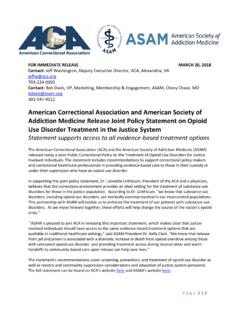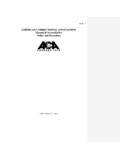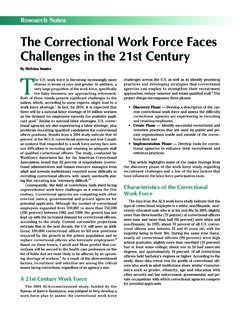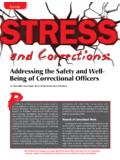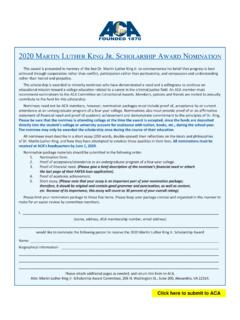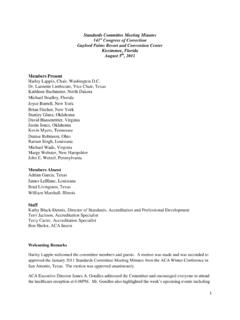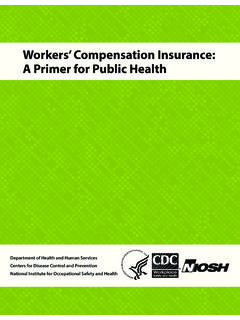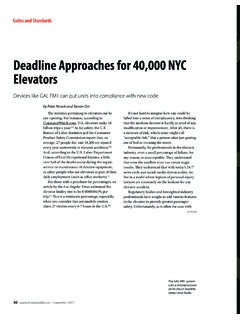Transcription of Research Notes U.S. Correctional Officers Killed or ...
1 Authors Note:Thefindingsand con -clusionsin this reportar e thoseof th eaut horsan d do not ne cessarily repr e-se nt the viewsof the NationalInsti tutefor OccupationalSafetyand Heal the , app roximately hal f amillioncorrectional Officers areres ponsiblefor supervisingmor ethan two mi lli on al of fice rs are ex pose d to uniqu eworkplaceha zardswith in a co ntr olledprisonenv ir onment. Of all . work -er s, Correctional office rs have on e ofthe hi ghestrates of nonfatal,wo rk-rela ted 20 11, correctionalofficersexper ience d 54 4 wor k-r elatedin ju ries or illnessespe r 10,000ful l-tim e employees (FTEs),whichwereseri ous enoughto re qui re tha t theymisseda day of was morethan four timesgreaterthan the ratefor all workerswho misseda day ofwork(117 cases per 10,000 FTEs).2 Also in 201 1, correctionaloff ice rsexp erienced254 work-rela ted injuriesper 10,00 0 FTEs due to assaults andvio lent acts.
2 This is consid er ab ly high -er thanthe rate of injuriesfromass aul t and violent acts for all workers(sevenper 10 ,0 00 FTE s).3De spitethesehigh injuryratesamongcorrectionaloff icers,injurypr eventionresearchhas lagge d. As animportant firs t step in the develop-men t of evidence-basedworkplacesaf ety programsfo r correctionaloffic ers , a completepictureof work-relatedinjuriesis re, theauth ors describe113 work-relatedfata lit ies and an esti mated125,200emergencyde partment (ED) trea ted,nonfatalwork-relatedinjur ies cor rectional officersfrom 1999throu gh 20 and Me thodologyInformationon work- relatedfat ali -ties was ob tai ned from the CensusofFatalOccupational Inj uries(CFOI).4Th is da tabasecaptureswork -rel atedfa talitiesfromall 50 state s and theDistrictof Columbia. Nonf atal injuryda ta were obtainedfrom the occ upa -tiona l supplement to the NationalElectronic InjurySurveillance System(NEISS-Work).
3 It collectsdata on non -fa tal, occupati onal ED-treatedinjuriesfrom a nationalstra tifiedprobabil it ysampleof 67 ho tali tie s amo ngcor rect ionalofficersfromthe CFOI database wereidenti fi ed usi ng st an -dardizednume ric occupationalcod NEISS-Work does no t conta in stan -dardizednume ric occupationalcod es,non fatal injurieswereidenti fie d bysearching an d reviewing th e empl oy -ment text fie lds for ke yw or ds re latedto the correctionalindustry;the co r-rectionalofficeroc cu pat ion; andun iqu e inju ry inci dentsrelatedto cor -rectionaloffic ers work activiti es ( ,supe rvising or restrainin g in mates,alte rc ation s with inmates, on-the-jobcorr ect iona l tr ainin g, contrabandsea rches,openingand cl osingof celldoorsand tran sp ortinginmates). CorrectionalOfficersKilledorInjuredon the JobBySrinivasKonda,HopeTiesman,AudreyRei chardandDanHartleyCharacteristicsNumber ofFatalitiesPercentNumber of Nonfatal Injuries ( CI)PercentSex Male1008991,700 ( 55,800)73 Female 131133,500 ( 15,200)27 Age group (in years) 18-2410910,100 ( 5,300)825-299821,900 ( 13,500)1830-3410924,900 ( 15,900)2035-39181620,300 ( 11,700)1640-44161419,900 ( 10,900)1645and older504427,900 ( 16,300)22 Year199910910,200 ( 6,500)82000121113,000 ( 7,000)1020017612,800 ( 7,800)102002161415,400 ( 9,900)122003131214,100 ( 9,400)112004548,600 ( 5,400)720056511,000 ( 6,200)92006111017,300 ( 11,400)142007141212,100 ( 7,000)102008191710,700 ( 7,000)9 Total113100125,200 ( 70,100)100 Table1.
4 FatalandNonfatalWork-Related Injurie s om19 99 Through2008 and perce ntag es werecalculated for diff erentcharacteris -tic s. Also, nation al fatal and nonfatalwork-related injur y rates wer e calcu -lated usinglabo r for ce data fro m theCurrentPopulation Surv ey (C PS) .Num bers and ra tes fro m su rvey dataare presented with 95 percentconfi -de nce intervals (CI), whichspec ify arangeof valu es descr ibing the un cer -tai nty of an CPS is anationalmo nth ly ho useholdsu rveyof approximately 50, 00 0 non inst it u-tiona li zed res identsage s 15 yearsan d dingsWork-relatedfata lities: Therewere113 corre cti ona loffic er fatalitiesre por ted th efatalityrate was per 100,000 FTEs (CI = ); On ave rag e, 11 wo rk -r elatedfatalitieswerereportedperyear; Malecorrection al offic ersincurred the majorityof fa ta li -ties and mo re th an two-thirdsoc curredto officersages 45and older; As saults,vio lent ac ts andtra nsportation-related fatal iti esaccountedfo r 80 percent of allfatalit ies; Amongfata l assaultsand vio -len t acts, 62 percentwere dueto homicidesand 38 percentweredue to suicidesby self -infl icted gun sh ot wounds.
5 And Of the homicides,65 perc entwereco mmittedby inmatesand the remainingwe re com -mittedby co wo rker s, str angersor per sonalrelations of thecorrectionaloffi fatal wor k-r elatedinjur ies: An est ima ted 125,200(CI = 70 ,100)nonfatalwor k- re la tedin ju ries wer e tr ea ted in EDs fo ra rate of (CI = ) per 100 FTE s; Themajo rityof nonfatalinjuriesocc urredto ma le co r-rectionalofficers; Half of the nonfatalinju rie swer e among officersag es 35yea rs and old er; The majorityof inju ries weredue to assa ul ts and vio lentacts, followed by ove re xert io n,and contactwith dangerousobjects and equ ip ment; Of the nonfatal assaultsand violentac t in juries,moretha n one- th ird (37 percent)occurr ed whilerestraini ng anin mateor in ter actingwi th anin mate du rin g an altercation; No nfatalinjuries primarilyaffe ctedthe upperlimb,with appr oxi matelytwo-thirdsaffectingthe handand fi ng ers;an d The mostcommontypesofwork- relatednonfatalinj uriesweresprainsand strains(30 percent),followedby con -tusionsan d ab rasions(28percent).
6 Dis cussio nDev el opinga correcti ona l offi -cers assaultand injury dat aba this stu dy, the authorsfou nd th atthe leadingeve nt s for both fat al andnonf atal work-related injuri es wereas sau lts and vio lent acts . To imple -menteffec tive workplace preventionefforts,it is esse ntial to collec t detailson the ci rc umstances of theseeve ntson a ile CF OI andNEISS-Work hav e a narra tive te xt fielddescribinginjurycircumstances,inf orm ationis limited. Con ver sel y,the na tionalreportby the Fe der alBu reau of In ve sti gatio n sLaw Enforce-me nt Of ficersKill ed andAssaultedprovidesdetailson info rma ti on sur -roundingassau lts on policeofficers,and safetytr ain in g can be de velo pedand delivered ba se d on data in thatEventNumber of FatalitiesPercentAssaults and violent acts4540 Homicides2825 Suicides1715 Transportation-related 4540 Falls1614 Other76 Total113(100)100 Table2. Fatal Work-RelatedInjur ie s to From1999 Through2008 Number of Nonfatal Injuries ( CI) Percent EventAssaults and violent acts47,500( 24,500)38 Contact with objects and equipment21,900( 16,800)18 Overexertion25,400( 12,500)20 Injured body partUpper limb37,500( 19,500)30 Hand andfinger23,500( 12,200)19 Trunk,neckand shoulder30,200( 16,900)24 Lower limb26,200( 16,200)21 Headandface:including eye, ear and mouth21,700( 11,800)17 Total125,200( 70,100)100 Table3.
7 NonfatalWork- Correction al OfficersFrom199 9 Through2008 bySelectedEvents an d InjuredBodyPartsrepor t. The re is no comparable data -base currentlymaintainedfor correc -tionalof fice rs at a natio nal lev el. Theongoing coll ec tion and analysisofsu ch data cou ld lead to the develop-men t and enha ncementof wor kplaceviolencepreventionefforts. Otherresearchers ha ve maderecommenda-tionsth at correctio na l fac ilitiessh oul d conductcentralized oragency-le vel surveillance to identi fyemergingproblemsrelatedto violentinjuries to corre ctionaloffi cers. Thiswouldinc lud e id entify ing the ty pe ofweaponsused in an assaultor co nfis -catedduringregular sea rc h effe ctivetraining,tea mwo rk and use of appro -pr iate pro tect ive equipmentha s alsobeenre commended to pre ve ntass aul t and ts werealso a leadingcauseof work-related fat alitiesamongcorr ectio nal office rs. This isnot surp risinggiventh at mo to r vehi -cle-r elatedev ents ar e the leadingcauseof work-related fat alitiesamo ng all wo , drivin gis a common task fo r correctionaloff icers,as theyofte n tran sportinm atesto hospitals and courtappearances.
8 Th e national In stitutefor OccupationalSaf ety and Hea lth(NI OSH) reco mmends th at employersde velopand enforcedr iver safetypolicies,mandate sea tb elt use,ensurere gular ly scheduledvehiclein spection an d maintenan ce , and pro -hi bit dr ivin g prac tices such as textingor cell gunshot woundsand sui ci de this study,theauthorsfoundthat 17 correctionalofficers died from self -in flictedgun -shot woun ds in the wor kp lac e du ringthe 10-y ear is kno wn thatcorrectionaloffi cer s experience con -stan t stressbe causeof fe ar of inmateatt acks,mandatoryove rtime,ro tat -in g shif ts, slee p distu rbancesandsupervisorydem ands .11 Job stressis sues are linkedto psyc ho log ic aldisordersthat may re sult in an ele -vate d suic ide risk .12A 2011 surve y ofcorrecti ons pe rso nn el revealedthatabouthalf of the st udy participantsexperiencedsome sig ns of post -traumaticstressdiso rder (PT SD)and confirmedthereis an elev atedsu icide risk due to anotherstudy,researchersfou nd that aboutone -th ird of corrections personnelwere cl inic ally dep y, the data in this studydoes notoffe r info rm ationon the motivesbehindth ese suicid es.
9 Additionalresearc h sho uld be conductedtoexa mine the as so ciationbetweenjobstre ss and sui cid e risk amo ng corr ec -tio nal of ficer s, an d then take stepstoal leviatejob stre national Ins titut e of Justicehas developed a publication and pro -vi ded a wid e va riety of appr oachestorelievestre ss amongcorrectiona s repo rt inclu des ca sestudiesof we ll- establishedand replic -able stres s redu cti on prog ra mswhi ch inclu de professionalcoun sel -ing, pee r supp ort, refe rralstocl in ician s or emp loyeeas sistanceprograms,an d staff rec -om mendscorrecti on al ag enc ieschoosea mo del and st ru ct ure astre ss reductio n programby combin-in g services acc ordi ng to depar tme ntneedsand resou rces .16 Also , NI OSH isdevelopinga customizedjob stresstool sp eci ficallyai med at examiningcorrectionalofficers perc eptio ns ofthe causesof stress,its effec ts ontheirheal th and the mostusefulresou rces to redu ce job st ,the autho rsfo und that cor rectionalofficerswereal so at ris k for nonfatalinjurydueto overexertion.
10 Theirjob dutiesinclu de a varietyof act ivi ti es thatincreasetheirrisk fo r st rain edmuscles, sp rain s and othermuscu-lo skel etal injur ies due to the use ofexcessive phy sical effort,awkwardbodyposturesand /or staticpos ac tivitiesin cluderes train -in g inmatesor breaking up fight s,movinghea vy fu rnitureor equip mentduringcontrabandsearchesandstandingf or a prolonged time tosuperviseinmat es. Researchamongpoli ce office rs an occupationwithsimila r ph ysical de man ds hasshowntha t hi gh er levelsof physi calactivityand fit ness ar e associatedwith a lowe r frequency of , job hazardana lysescouldbe performedtoid entifycont ribut ing factorsandpot entialareasfor overexertionsafetyimp ro ve ment nal offic ers are at ri sk fo rwork-relatedinjuriesdue to bothfata l and no nfat al as saultsandvi ole nt acts, transporta tion- re lat edfatal itie s and overexerti on. Whil ethereare someprevention effortscurrentlyin placeto reduceinmateassaults, eff or ts to red uce otherwor k-related inj uries are rare.
